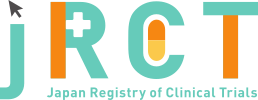臨床研究等提出・公開システム
|
Mar. 26, 2019 |
|
|
Oct. 31, 2022 |
|
|
jRCTs031180429 |
A randomized, open, Phase II comparison of the safety and efficacy of a reduced and re-escalated dose of sorafenib versus a reduced and maintained dose of sorafenib in patients with advanced hepatocellular carcinoma |
|
Dose re-escalation study of sorafenib in patients with HCC |
|
Oct. 31, 2018 |
|
114 |
|
First enrollment: 114 patients Stud drug administration: 113 patients Second enrollment: 48 patients Re-escalation dose group: 24 patients Reduced dose group: 24 patients At the time of first enrollment (n = 113) Age (median): 70 years (39-84), male: 94 pt (83.2%), HBV: 21 pt (18.6%), HCV: 56 pt (49.6%), ECOG-PS 0: 100 pt (87.7%), Child-Pugh score 5: 67 pt (59.3%), Child-Pugh score 6: 31 pt (27.4%), Child-Pugh score 7 : 15pt (13.3%), MVI: 35 pt (31.0%), EHM: 47 pt (41.6%), BCLC stage C: 68 pt (60.2%),AFP >400 mg/dL: 52 pt (46.0%), pre-treatment: 105 (93.0%) At the time of second enrollment Re-escalation dose group (n = 24) Age (medina): 71 years (60-83), male: 22 pt (91.7%), HBV: 3 pt (12.5%), HCV: 15 pt (62.5%), ECOG-PS 0: 23 pt (95.8%), Child-Pugh score 5: 15 pt (62.5%), Child-Pugh score 6: 5 pt (20.8%), Child-Pugh score 7:4 pt 16.7% ),MVI: 2 pt (8.3%), EHM 9 pt (37.5%), BCLC stage C: 15 pt (62.5%), AFP >400 mg/dL: 8 pt (33.3%), pre-treatment: 23 pt (95.8%) Reduced dose group (n = 24) |
|
Number of enrollment (number of second enrollment) Start date - 31st March 2015: 19 patients (5 patients) 1st April 2015 - 31st March 2016: 33 patients (15 patients) 1st April 2016 - 31st March 2017: 40 patients (19 patients) 1st April 2017 - Finish data: 22 patients (9 patients) |
|
Frequencies of adverse events are indicated the next section. Cases sever adverse events during the present trial was listed as bellow. #1 Tumor lysis syndrome (Grade 3, not related) #2 Esophagus hemorrhage (Grade 5, not related) #3 Tumor lysis syndrome (Grade 3, related) #4 Tumor lysis syndrome (Grade 3, related) #5 Ascites (Grade 3, not related) #6 Death (Grade 5, unknown) #7 Heart failure (Grade 3, not related) #8 Esophagus hemorrhage (Grade 5, not related) #9 Stomach hemorrhage (Grade 3, related) #10 Stroke (Grade 3, not related) #11 Pain (Grade 3, not related) #12 Hepatocellular carcinoma (underlying disease (Grade 5, not related) #13 Liver failure (Grade 5, not related) |
|
Primary endpoint Time to progression after randomization Re-escalation dose: 2.8 months (95%CI, 2.3-4.2) Reduced dose: 2.6 months (95%CI, 0.9-4.3) P = 0.868 Secondary endpoints Overall survival Re-escalation dose: 27.5 months (95%CI, 12.0-undefined) Reduced dose: 17.8 months (95%CI, 11.8-39.9) P = 0.676 Overall survival after randomization Re-escalation dose: 25.6 months (95%CI, 10.1-undefined) Reduced dose: 15.9 months (95%CI, 9.7-38.0) P = 0.705 Time to progression e-escalation dose: 4.7 months (95%CI, 4.6-6.5) Reduced dose: 4.7 months (95%CI, 2.9-6.5) P = 0.905 Drug concentration of sorafenib Week 4 Re-escalation dose group: 5.58 (2.67) Reduced dose group: 3.91 (0.75) Week 8 Re-escalation dose group: 4.45 (3.74) Reduced dose group: 2.30 (0.94) Week 12 Re-escalation dose group: 5.71 (3.31) Reduced dose group: 2.50 (1.19) Safety Before second enrollment The most common adverse events were hypertension (re-escalation dose: 70.8%, reduced dose: 70.8%, lipase increased (re-escalation dose: 70.8%, reduced dose: 70.8%), palmoplantar erythrodysesthesia,(re-escalation dose: 62.5%, reduced dose: 50.0 %,), hypophosphatemia (re-escalation dose: 58.3%, reduced dose: 41.7%), and amylase increased (re-escalation dose: 54.2%, reduced dose: 50.0%). After second enrollment The most common adverse events were hypertension (re-escalation dose: 70.8%, reduced dose: 56.5%), palmoplantar erythrodysesthesia, (re-escalation dose: 58.3%, reduced dose: 39.1 %), and hypoalbuminemia (re-escalation dose: 54.2%, reduced dose: 39.1%). |
|
Time to progression after randomization, which was the primary endpoint of this study, were not significantly longer in the re-escalation dose group compared with that of the reduced dose group. Moreover, other secondary endpoints did not suggest effectiveness of the re-escalation dose group as well. There were no adverse events which increased significantly in the re-escalation dose group compared with the reduced dose group. |
|
Oct. 31, 2022 |
|
No |
|
We did not plan IPD in the present trial. |
|
https://jrct.niph.go.jp/latest-detail/jRCTs031180429 |
Kato Naoya |
||
Chiba University |
||
1-8-1, Inohana, Chuo-ku, Chiba city, Chiba, Japan |
||
+81-43-222-7171 |
||
kato.naoya@chiba-u.jp |
||
Ogasawara Sadahisa |
||
Chiba University |
||
1-8-1, Inohana, Chuo-ku, Chiba city, Chiba, Japan |
||
+81-43-222-7171 |
||
ogasawaras@chiba-u.jp |
Complete |
July. 08, 2014 |
||
| July. 08, 2014 | ||
| 250 | ||
Interventional |
||
randomized controlled trial |
||
open(masking not used) |
||
historical control |
||
parallel assignment |
||
treatment purpose |
||
1) Age: 20 years or more |
||
1) Patients with a history of malignant tumors except for the following cases. |
||
| 20age old over | ||
| No limit | ||
Both |
||
Hepatocellular carcinoma |
||
sorafneib |
||
Chemotherapy |
||
Molecular targeted agent |
||
013 |
||
Time to progression after randomization |
||
Overall survival |
||
| Bayer Yakuhin.Ltd. | |
| Not applicable |
| Chiba University Certified Clinical Research Review Board | |
| 1-8-1, Inohana, Chuo-ku, Chiba-City, Chiba, Japan, Chiba | |
+81-43-226-2616 |
|
| prc-jim@chiba-u.jp | |
| Approval | |
Feb. 27, 2019 |
| UMIN000014566 | |
| UMIN |
none |
